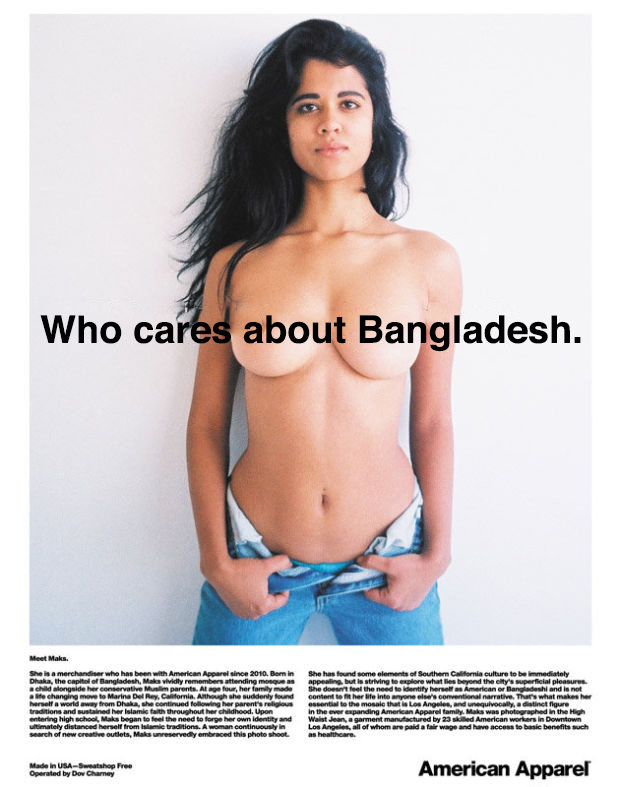DISCLOSURE: Please be advised that there is nudity in this post provided by American Apparel, read/view at your own caution!
It’s really hard to miss an American Apparel ad. Whether if you are walking by an American Apparel storefront, or perhaps perusing through the magazine catalogues, the presence of risqué images including minimally dressed and physically fit models are really hard to miss.
American Apparel prides itself on having North American made clothes as opposed to most companies that outsource their work to other countries with poor working conditions and very low pay. As you can see, the country in contrast is Bangladesh. However, very little information is presented about the issues of working conditions in Bangladesh, attention is focused on neoliberal American ideals, freedom of choice, and freedom of religion. The text on top of the model’s topless body reads, “Made in Bangladesh.” this phrase, as it turns out, has little to do with Bangladesh, but serves as a reference for what America is not.
 Photo Credit: American Apparel
Photo Credit: American Apparel
Meet Maks,
She is a merchandiser who has been with American Apparel since 2010. Born in Dhaka, the capital of Bangladesh, Maks vividly remembers attending mosque as a child alongside her conservative Muslim parents. At age four, her family made a life changing move to Marine Del Rey, California. Although she suddenly found herself a world away from Dhaka, she continued following her parent’s religious traditions and sustained her Islamic faith throughout her childhood. Upon entering high school, Maks began to feel the need to forge her own identity and ultimately distance herself from Islamic traditions. A woman continuously in search of new creative outlets, Maks unreservedly embraced this photo shoot.She has found some elements of Southern California culture to be immediately appealing but is striving to explore what lies beyond the city’s superficial pleasures. She doesn’t feel the need to identify herself as American or Bangladeshi and is not content to fit her life into anyone else’s conventional narrative. That’s what makes her in the ever expanding American Apparel family. Maks was photographed in the High Waisted Jean, a garment manufactured by 23 skilled American workers in Downtown Los Angeles, all of whom are paid a fair wage and have access of basic benefits such as healthcare.
On the bottom of this ad, an introduction of the topless woman is introduced as Maks, a merchandiser at American Apparel. The paragraph goes to lengths about how Maks moved to California from Dhaka, Bangladesh, describing her geographical move from one side of the world to another and a move to “forge her own identity and distancing her self from Islamic traditions”. The paragraph goes on to describing all the opportunities America offers to Maks, she neither identifies as American or Bangladeshi, and is conveys a sense of freedom to be whatever she desires as she is “not content to fit her life into anyone else’s conventional narrative”.
There are a few problems I find about this advert. One, this example is one of the hundreds of images used to convey the same idea of the female body. Lacking in diversity in terms of different ethnicity, sexual representation is confined to biological standards of gender and sex, no representation of other bodies and sexualities of LGBTQ + or able/disabled people. Another main issue one can argue is the fact that this ad has very little to do with the human rights and workers. These issues are still prevalent in Bangladesh leaving the women working in manufacturing factories in Bangladesh an issue that is rendered invisible and unimportant because apparently, living in America can erase your problems of gender, class and race.
 Photo Credit: American Apparel, Image Altered by: May Lum with Photoshop.
Photo Credit: American Apparel, Image Altered by: May Lum with Photoshop.
Presented above is the culture jammed version of this ad. I’ve taken out the words on her chest that read “Made in Bangladesh.” and replaced it with “Who cares about Bangladesh.” in the same manner of a statement rather than a question. This project wanted us to deconstruct the image and interpret the ad in another light; I believe that the jammed version of this ad is aims to address the idea of neoliberal choice and the ignorance, which hinders the larger issues at hand.
Naked bodies for ads often display signs of courage, boldness, and a clear idea of the female body. One can argue that American Apparel ads are a great example of the phrase, “sex sells” which is exactly what these ads are doing. What is being sold to the consumer here is the idea of what the female body should look like, much like the other American Apparel ads out there, the same types of bodies are recycled over and over again to portray the same meaning. American Apparel ads are known to carry heavy loaded meanings that convey heteronormativism, ablism; and although a lot of sex and sexuality, a static understanding of gender fluidity without other representations of other sexualities.
It was evident to me that this original ad also negates complexities by glossing over complex issues, the message’s solution seemed to be that by ‘Americanizing’ the situation, (moving to America, adopting American ideals, adopting American popular religions, etc…) one is able to simply erase all issues at the individual level. However, problems specifically targeted towards manufacturing and workers conditions are more of a structural issue than it is a small nuisance that can be swept under the proverbial rug. This ad merely scratched the surface of these issues and failed heavily to address the severity of the problem, as I believe that this ad was meant for consumers to buy into the American ideal that comes along with American Apparel clothing.
References
http://AmericanApparel.com
